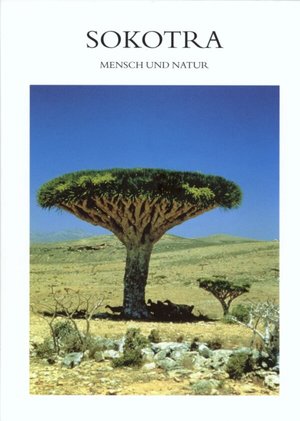
Sokotra
Mensch und Natur
von Wolfgang Wranik
Die dem Horn von Afrika vorgelagerte Inselgruppe Sokotra gilt als eine der am meisten isolierten Landmassen in der Erdgeschichte. Ihre einzigartige Tier- und Pflanzenwelt bewog einige Wissenschaftler dazu, von einem „lebenden botanischen Museum“ oder einem „Galapagos des Indischen Ozeans“ zu sprechen. Es finden sich Reliktformen einer afrikanisch-arabischen, alttertiären Flora und Fauna sowie Neoendemiten, die sich nach einem zufälligen Siedeln auf den Inseln ausbreiten und in den zahlreichen ökologischen Nischen des Archipels neue Arten ausbilden konnten. Von den etwas über 800 bisher auf Sokotra nachgewiesenen Gefäßpflanzenarten gelten knapp 30% als endemisch. Unter den ca. 800 bisher erfaßten Tierarten finden sich ebenfalls zahlreiche entwicklungsgeschichtlich und biogeographisch interessante Formen. So gelten allein 19 Reptilien- und mindestens sechs Vogelarten als einheimisch.
Doch nicht weniger faszinierend ist Sokotras Kulturgeschichte. Spuren der Herkunft der heutigen Bevölkerung führen nach Südarabien und die Westküste Indiens, nach Afrika und nach Europa. Etwa ein Drittel der Menschen sind Bergbewohner. Sie werden zu den Nachfahren der Ureinwohner gerechnet, leben in Großfamilien nach sehr traditionellen Prinzipien und betreiben Viehzucht. Sie sprechen „Socotri“, eine sehr alte, schriftlose Sprache.
Für die Abgeschiedenheit Sokotras gab es politische Gründe, aber auch wirksame natürliche Barrieren. Diese komplizierten Bedingungen haben unter den Bewohnern traditionelle Formen des Arbeitens und Zusammenlebens fortbestehen lassen, die von Einfachheit, gegenseitiger Hilfe und einer Nutzung der begrenzten Ressourcen im Einklang mit der Natur bestimmt sind. Dadurch gilt Sokotra als eine der vom Naturzustand her am besten erhaltenen tropischen Inseln der Erde. Doch Naturnähe und harmonisches Zusammenleben der Menschen ist nur die eine Seite des Inseldaseins. Die andere besteht in sehr schwierigen Lebensbedingungen. Fast unbemerkt von der breiten Öffentlichkeit vollziehen sich derzeit auf Sokotra tiefgreifende Veränderungen. Doch durch die besondere Empfindlichkeit von Inselökosystemen könnten die Folgen unüberlegter Maßnahmen erheblich sein. Deshalb bemüht sich der Jemen mit Unterstützung internationaler Organisationen seit einigen Jahren um ein Konzept einer „nachhaltigen Entwicklung“ im Sinne der Umweltkonferenz von Rio.
Das vorgelegte Buch gibt eine Übersicht zur Natur- und Kulturgeschichte Sokotras und zeigt die Inselgruppe im Spannungsfeld zwischen Schutz und Entwicklung.
The Socotra Archipelago, which is situated in the north-western part of the Inian Ovean, still belongs to the comparatively unexplored parts of the world. Apart from some 19th century travel accoubts the island has been a relatively well-kept secret, virtually isolated from the rest of the world and effectively closed for foreign visitors because of military considerations and extreme natural conditions.
The fascinating and unique character of the flora and fauna of Socotra is related to its geological history. The island is probably part of a fault block separated off from the mainland by the same series of dislocations which produced the Gulf of Aden in Tertiary times and it is considered by geologists as one of the „mostisolated pieces of land“ in the history of the earth. the high degree of endemism, as a result of this long isolation, makes the Archipelago of remarkable biogeographic and evolutionary interest and an important place in terms of global wildlife conservation.
Although the geological history of the island is in many details still imperfectly known, it is possible to suggest that some of the endemic species are relics of an ancient flora and fauna surviving in the massif of Socotra, which is considered not to have submerged since the Mesozoic.
Altogether some 850 plant species have been recorded so far, about 270 of which are considered to be endemic. Among them there are strange-looking remnants of ancient floras, which long ago disappeared from the surrounding mainland. Perhaps the most strikingly plants are the dragon’s blood tree and the bizarre tree succulents, the desert rose, and the cucumber tree. Equally fascinating is the land and freshwater fauna, whith an exceptional number of endemics, but above all, comparatively poorly studied. Among the land birds at least 6 species, as well as 12 sub-species, are restricted to Socotra. The reptilian fauna is also very rich with 21 out of a total of 24 species regarded as endemics. But a significant part of the available data on the flora and fauna of Socotra dates back to turn-of-the-century expeditions. this, in turn, creates severe problems for a well-prepared protection strategy and means a definite need for field surveys of any kind. Beside all these biological peculiarities the cultural history of human inhabitant on the island is equally interesting. Arabs, Africans, Greeks and Portugueses came o the island to different times and contributed their part to its own manners, cultures and spiritual idea. There is a special language of the nomacid hill tribes, which has no writing. The transhumant indigenous people of the interior are subsistent farmers and pastoralists, while coastal dwellers engage mostly in fishing and trade. Principles of cooperation, self-help and community labour are well established, and there is also a whole rabnge of relevant traditional rules and practices which are of economical importance.
The opening of the island a few years ago has stimulated plans to improve the poor living conditions and infrastructure. This marks a crucial turning point for the Archipelago, which represents a fragile ecosystem.






